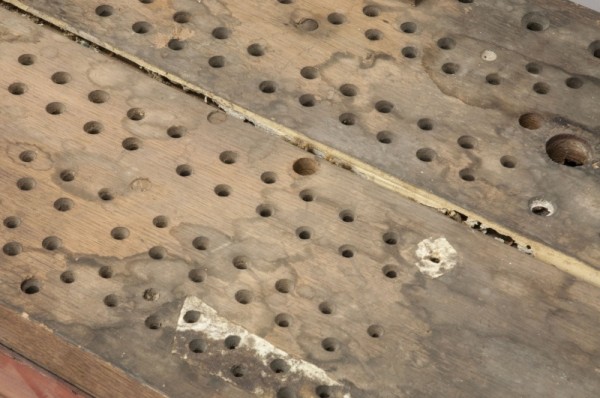A toe board looks like a solid board with slightly funnel-shaped holes for the pipes (see wind-chest diagram), but the boards are anything but solid. …
Finding "Blow" in the Wind-chest
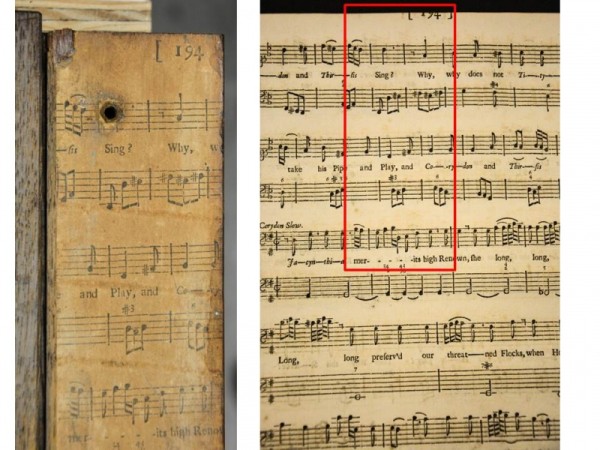
Music Paper was used to prop the toe boards above the sliders to allow the sliders to move
By John Watson
Perhaps it seemed only natural that the original makers of the organ wind-chest chose old printed music to use as paper shims. The music paper was added to build up the thickness of the bearers so they would stand a single thickness of paper higher than the sliders, allowing the sliders to shift without binding under the toe boards (see wind-chest diagram).
I wondered whether the music could have been some old unsold stock from music merchants Longman & Broderip. L&B had recently gone out of business at the time James Longman, Muzio Clementi and their partners started Longman, Clementi & Co., producing this organized piano in their first year (1799).
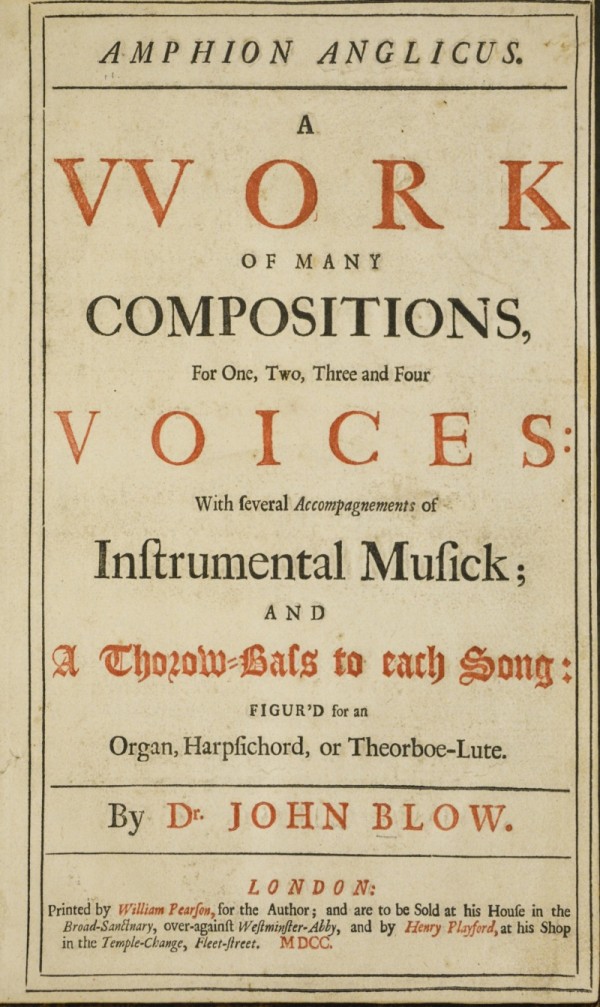
Title page of Amphion Anglicus, the anthology of music published by John Blow in 1700. Colonial Williamsburg Special Collections
Dr. Nikos Pappas came through the lab last week and spotted the music paper glued to the wind-chest. Nikos, a musicologist here in Williamsburg for a research fellowship at our library, made a surprising observation. Nikos pointed out that the music was printed using movable type. That technology for printing music had been replaced by engraving early in the 18th century. The music paper was much earlier than I thought.
Taking into account that some of the paper fragments had page numbers up to 204, Nikos knew that very few books of music in that early period had so many pages. He had already spotted one of them in the special collections of Colonial Williamsburg’s John D. Rockefeller Jr. Library. It was Amphion Anglicus, an anthology of music composed and published by the celebrated early English composer John Blow in the year 1700.
The next day, I made an appointment to see our original copy of Amphion Anglicus. With a photograph of one of the paper shims bearing the page number 199, I asked Doug Mayo in the library’s Special Collections to turn to page 199.
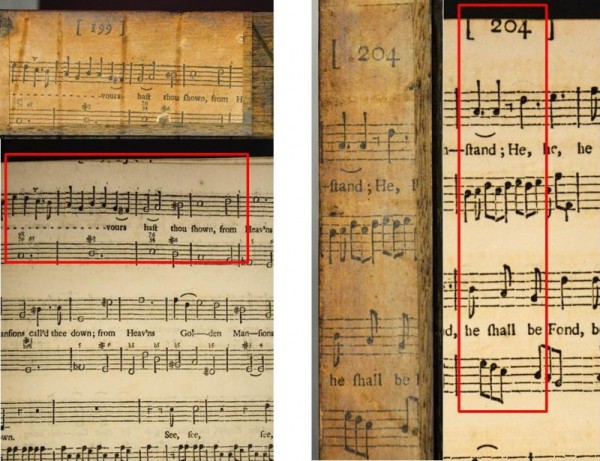
Two of the paper shims from the wind-chest (darker) next to the corresponding pages in the original 1700 publication. Colonial Williamsburg Special Collections
Voila! It was a perfect match.
The workmen had cut up what was already a 99-year-old book of music, composed and published by John Blow one year after Blow’s appointment as composer to the Chapel Royal.
Today, of course, no one would think of cutting up a first edition of John Blow’s Amphion Anglicus. Undoubtedly, Blow is venerated among today’s early-music enthusiasts more than he was in 1799. Perhaps the paper was the right thickness for the shims. Or perhaps the organbuilder just had a sense of humor, putting “Blow” in the wind-chest.
In the next post, we’ll look take a major step in the restorative conservation of the wind-chest.
Conservation of the Tucker organized piano is made possible by a gift in memory of N. Beverley Tucker, Jr.
The Wind-Chest During Treatment
With chalk marking areas of detachment, fine holes just large enough to insert a hypodermic needle are drilled into the thin table board.
By John Watson
Two centuries of dust accumulation and the detritus of a few generations of mice had left the wind-chest congested with debris….
The Wind-Chest Before Treatment
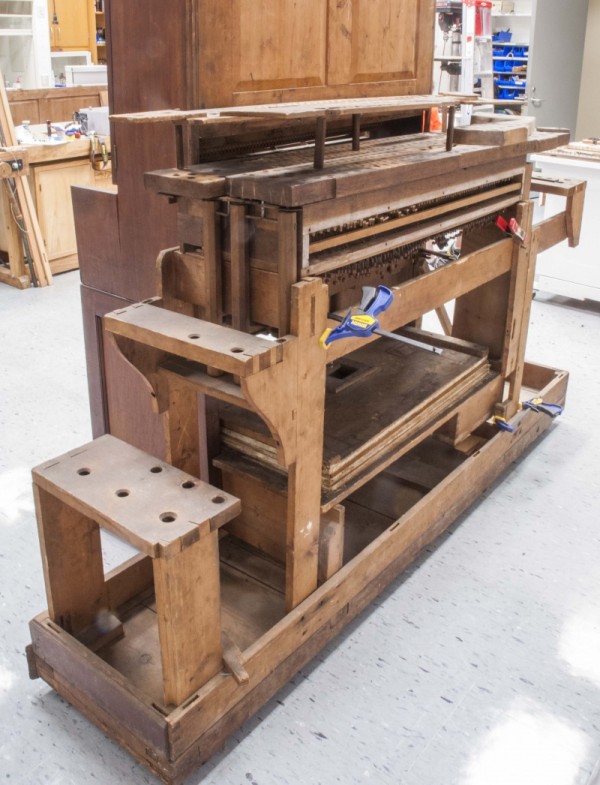
The wind-chest sits on top of the chassis just behind the upright grand piano. The organ’s pipes and outer casework are removed.
By John Watson
We’re back after some re-organization of the blog….
Pipes are Straightened
Before treatment, the pipes were bent, torn, and twisted.
By John Watson
The badly twisted, torn and mangled pipes are among the more daunting problems to be solved in the treatment of the “Tucker” organized upright grand piano. A conventional approach to restoration would probably involve replacing them with new ones. Some restorers have even melted down original pipes to make new ones, copying the old dimensions as a method of preserving them. But as we will see, dimensions and even the metal alloy itself are not the only, or even the main things we are here to preserve.…
The Pipe Treatment Begins
By John Watson
The first step: Inventory the pipes and determine what is missing. For this, we turned to veteran organ-pipe maker Louis Dolive….
A Conservation Pipeline
By John Watson
Restorative conservation of the Tucker instrument will begin with one of our more daunting challenges: to straighten the severely damaged metal pipes. While the wood pipes survived in relatively good condition, the metal ones were hardly recognizable as organ pipes. All were crushed and folded so even the longest pipe could fit in a 24-inch long cardboard box.
…
Another Organized Piano?
The Rolfe-Sellers organized square piano. The organ is surrounded by panels of cloth and gilded pipes.
By John Watson
Our good friend and colleague in South Carolina, Tom Strange, recently sent an email with a startling offer. …
Staring down a paradox
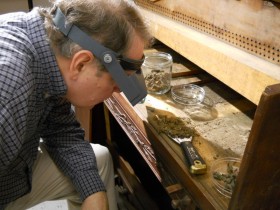
A heavy layer of dust and debris under the keys is full of clues, including the only surviving evidence of the original green silk that originally covered the doors.
By John Watson
In the first installment of this blog, I claimed that restoration is a paradox. A paradox is a contradiction, both sides of which are true….
